NavSource Online: Escort Carrier Photo Archive
(BAVG-4) / HMS CHARGER (D27) /
USS CHARGER (AVG-30)
(later ACV-30 and CVE-30)
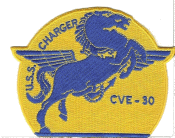
Contributed by Tommy Trampp





| Charger Class Escort Carrier | |||||
| Ordered | Laid down | Launched | Commissioned | Decommissioned | Stricken |
|---|---|---|---|---|---|
| (see below) | 19 Jan 1940 | 1 Mar 1941 | 3 Mar 1942 (USN) | 15 Mar 1946 | 28 Mar 1946 |
| Builder: Sun Shipbuilding & Drydock Co., Chester, Pa. | |||||
| Click on Thumbnail for Full Size Image |
Size | Image Description | Source | |
|---|---|---|---|---|
| Construction |
||||
 NS030100304 |
53k | Rio Hudson, Rio Parana and Rio de la Plata just prior to conversion. | Hazegray & Underway | |
| Name |
||||
 NS0303022 |
196k | This vessel was built as the civilian passenger/cargo ship Rio de la Plata. Acquired by the US Navy on 20 May 1941, converted to an aircraft carrier and transferred to the Royal Navy, that named her Charger—on 2 October 1941 Lt. Cdr (E) R.F. McArt RNR was present at the Newport News S.B. & D.D. yard as the RN Officer in Charge. Two days later Charger was returned to the US Navy, that had decided to use her as a training carrier. In US service, she retained her British name—"Charger" is a horse ridden by a knight or cavalryman. |
NavSource | |
| World War II |
||||
 NS0303001 |
66k | Good overhead, port side view. | USN | |
 NS0303003 |
137k | Good overhead, starboard side view. | USN | |
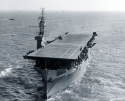 NS0303038 |
159k | USS Charger underway, date and location unknown. |
David Buell | |
 NS0303002 |
1.15M | USS Charger (ACV-30), 1942. From Division of Naval Intelligence, Identification and Characteristics Section, published in June 1943. NS0303002b: USS Charger stbd., broadside, Norfolk Navy Yard Portsmouth, VA., Photo serial 3009(42) April 15, 1942. |
Tommy Trampp David Buell |
|
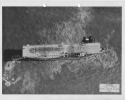 NS0303002a |
1.26M | David Buell | ||
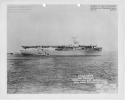 NS0303002b |
1.20M | |||
NS0303010 |
56k | USS Charger (CVE-30) underway circa 1942, location unknown. |
Robert Hurst | |
 NS0303011 |
134k | USS Charger (CVE-30) at anchor circa 1942, location unknown. Photo from Navy Yearbook, ed. by Phillip Andrews and Leonard Engel; Duell, Sloan and Pearce, 1944. (See NS0303019–NS0303019a.) |
Original photo and caption submitted by Robert Hurst. Larger photo by Derick Hartshorn |
|
 NS0303019 |
115k | USS Charger (AVG-30, later CVE-30) at anchor, 12 May 1942. She is painted in Camouflage Measure 12 (Modified). Official U.S. Navy Photograph, from the collections of the Naval History and Heritage Command (# NH 55073). |
Robert Hurst | |
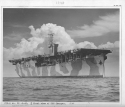 NS0303019a |
188k | "¾ front view of USS Charger." Same photo as NS0303011 and NS0303019. This appears to be the original picture, with NS0303011 retouched/censored to remove the camouflage and antennas, and NS0303019 retouched/censored to remove the clouds. National Archives and Records Administration (NARA), College Park, photo # 80-G-13142. Original caption suggests the date was 12 May 1942, but Charger's war diary has her at Norfolk undergoing availability from May 7th to the 19th, at which point she anchored in Chesapeake Bay for a day before running flight training operations for the rest of the month. |
Tracy White, Researcher @ Large | |
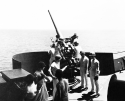 NS0303037 |
370k | Aboard USS Charger (AVG-30), 3-inch Gun Crew standing by, June 1942. U.S. Navy photograph, now in the collections of the National Archives and Records Administration (NARA), # 80-G-13386. |
NARA | |
 NS0303040 |
563k | USS Charger (AVG-30, later CVE-30), three-quarter aft view while underway, June 1942. She is painted in Camouflage Measure 12 (Modified). National Archives and Records Administration (NARA), # 80-G-13143. |
National
Museum of the US Navy, via Darren Large |
|
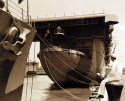 NS0303040a |
427k | USS Charger (AVG-30, later CVE-30), view of stern, June 1942. She is painted in Camouflage Measure 12 (Modified). National Archives and Records Administration (NARA), # 80-G-13144. |
||
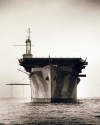 NS0303040b |
469k | USS Charger (AVG-30, later CVE-30), bow view, June 1942. She is painted in Camouflage Measure 12 (Modified). National Archives and Records Administration (NARA), # 80-G-13148. |
||
 NS0303023 |
63k | "First Series of Pictures aboard USS Charger, a former merchantman now converted to an aircraft carrier. Signal officer on the flight deck signals the incoming plane, 'Prepare to land.'" Courtesy of the Kibbe Museum. |
Bill Gonyo | |
 NS0303025 |
93k | USS Charger (AVG-30), 1942 identification photos. |
Tommy Trampp | |
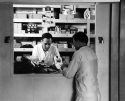 NS0303048 |
613k | USS Charger (AVG-30), ship's canteen, July 1942. Official U.S. Navy Photograph, now in the collections of the National Archives and Records Administration (NARA), # 80-G-39338. |
NARA | |
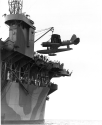 NS0303026 |
91k | An OS2U Kingfisher seaplane is lifted aboard the auxiliary carrier USS Charger (ACV-30) on 3 August 1942, at an unknown location. National Naval Aviation Museum photo (# 2004.166.003.013). |
Mike Green | |
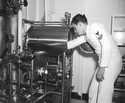 NS0303026a |
130k | "USS Charger (CVE-30) 3 August 1942—Modern sterilized equipment is carried onboard the ship to provide antiseptic medical supplies for the sick-bay and operating room. Shown here is a Navy corpsman loading the autoclave to sterilize surgical instruments packs for the operating room. An autoclave is a pressure chamber used to sterilize equipment and supplies by subjecting them to high pressure saturated steam at 121 °C (249°F) for around 15–20 minutes depending on the size of the load and the contents. Official photograph of the United States Navy." |
Bill Gonyo | |
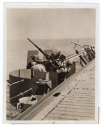 NS0303030 |
89k | "DIVE BOMBERS, BEWARE!—WASHINGTON—This former merchant ship has nothing to fear from enemy planes. The vessel is equipped with Oerlikon 20-millimeter anti-aircraft guns, which are remarkably effecive against low-flying aircraft. Besides, the former merchantman is now the U.S. aircraft carrier Charger, and carries warplanes of her own." Official U.S. Navy photo from ACME, 4 August 1942. |
Duane Bass, nky-photos.com | |
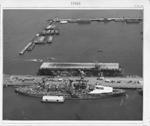 NS013442n |
802k | Battleship USS New York (BB-34) and auxiliary aircraft carrier USS Charger (ACV-30) waiting to go east at Norfolk Naval Yard, Portsmouth, VA, 11 August 1942. US National Archives photo (# 80-G-11058) from NARA, College Park, Maryland. |
Sean Hert | |
NS0303013 |
77k | USS Charger (ACV-30) in Measure 22 camouflage scheme is being maneuvered by tugs, 24 September 1942, at an unknown Chesapeake Bay location. Except for two aircraft ferrying operations in October 1942 and September 1945, the ship's basic WW2 task was that of training pilots and ships' crews in carrier operations, in Chesapeake Bay. |
Mike Green | |
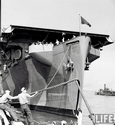 NS0303029 |
131k | Starboard bow view of USS Charger (ACV-30) moored at an unknown Chesapeake Bay location in September 1942. Except for two aircraft ferrying operations in October 1942 and September 1945, the ship's basic WW2 task was that of training pilots and ships' crews in carrier operations, in Chesapeake Bay. Charger had two near sisters in the Royal Navy (Archer class): HMS Biter (D97) and HMS Dasher (D37), all converted from Type C-3 passenger/cargo ships and transferred to the Royal Navy. Charger was originally slated to be HMS Charger (D27), but the USN decided to keep her for training purposes. Photo from the LIFE Magazine Archives, Joe Scherschel Photographer, shared by Peter DeForest (for educational and non-commercial use only). |
Mike Green | |
 NS0303030 |
96k | Rudimentary island structure on USS Charger (ACV-30), as seen during training operations in September 1942. Unlike other carriers, the island was built out over the side of the ship to entirely clear the flight deck. It was not supported by the hull or the hangar side, thus requiring dedicated supports. Photo from the LIFE Magazine Archives, Joe Scherschel Photographer, shared by Peter DeForest (for educational and non-commercial use only). |
Mike Green | |
 NS0303031 |
114k | Rudimentary island structure on USS Charger (ACV-30), as seen during training operations in September 1942. Unlike other carriers, the island was built out over the side of the ship to entirely clear the flight deck. It was not supported by the hull or the hangar side, thus requiring dedicated supports. Photo from the LIFE Magazine Archives, Joe Scherschel Photographer, shared by Peter DeForest (for educational and non-commercial use only). |
Mike Green | |
 NS0303043 |
1.16M | "'Pinch Hitting' as a Carrier for Uncle Sam—A former merchantman under another name, the U.S.S. Charger is one of a number of converted ships that have gone to war for Uncle Sam as aircraft carriers. Just how many of these are in commission is a military secret, but it has been formally announced that the Charger is one of those now in service to augment this all-important element of naval power in this war. These ships, for some operational purposes, are not in a class with the swift, tougher and more heavily gunned aircraft carriers designed and built as such. But they are of great value in transporting planes ready to strike, in moving them up to within striking distance of an enemy force or position while staying 'outside' of action as much as possible themselves. At the same time they are armed to give a good account of themselves against air, submarine and even destroyer attack." The Sunday Star, Washington, D.C. 15 November 1942. Chronicling America. |
Via Michael Mohl | |
 NS0303032 |
159k | USS Charger's wardroom, 1942. CAPT Thomas Lamison Sprague, ship's CO, head of table; CDR Steven Ward Callaway, XO, on his left; CO Training Squadron (TRARON) 22 on his right. |
Ron Reeves | |
 NS0303032a |
131k | |||
 NS0303032b |
129k | |||
 NS0303004 |
112k | USS Charger underway in 1943. For most of her career she was camouflaged in Measure 22, the graded system. Measure 22, introduced in June 1942, was intended for use in areas where bright weather and fair visibility predominated. Hull, from boot-topping to the lowest point of the main deck edge, was painted navy blue; the upper edge of this band was parallel to the horizon. Vertical surfaces above this blue band were painted haze gray. Flight deck was stained deck blue. Photo by Edward L. Walger PH2 USN, 1942-1945. |
Barbara Walger | |
 NS0303004a |
117k | Official USN photo, taken in January 1944 but otherwise very similar to NS0303004, above. |
David Buell | |
 NS0303007 |
96k | A Grumman F6F Hellcat that came in too low... 1943.
Photo by Edward L. Walger PH2 USN, 1942-1945. The ship's deck log for Saturday, 14 August 1943, may explain this photo: 1344 F6F airplane Bureau No. 25866 Piloted by Lieutenant C[harles] W. Harbert, USNR., attempting to land aboard, crashed into after searchlight platform and ramp of flight deck. Pilot received contusion of left shoulder and abrasions of chest. Plane was sever[e]ly damaged. |
Barbara Walger | |
 NS0303035 |
951k | Crash of a TBF-1 Avenger on the flight deck of USS Charger (ACV-30), 16 March 1943. U.S. Navy photograph, now in the collections of the National Archives and Records Administration (NARA), # 80-G-38862. |
David Wright | |
 NS0303035a |
530k | Crash of TBF-1 Avenger on the flight deck of USS Charger (ACV-30). Image shows how plane hit stack. Photographed 16 March 1943. U.S. Navy photograph, now in the collections of the National Archives and Records Administration (NARA), # 80-G-38863. |
NARA | |
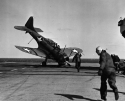 NS0303035b |
607k | Barrier crash of SBD-4 Dauntless positioned on the flight deck of USS Charger (ACV-30). Photographed 16 March 1943. U.S. Navy photograph, now in the collections of the National Archives and Records Administration (NARA), # 80-G-38875. |
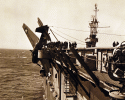 NS0303036 |
874k | Crash of TBF-1 Avenger on deck of USS Charger (ACV-30), photographed 23 March 1943. According to the ship's war diary, this was TBF-1, BuNo 00593, piloted by ENS Richard J. Walsh, USNR, which crashed into port catwalk on landing at 1152 and caused major damage to plane, no injuries. This occurred in Chesapeake Bay. U.S. Navy photographs, now in the collections of the National Archives and Records Administration (NARA):
|
David Wright |
 NS0303036a |
1.04M | |||
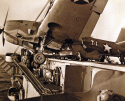 NS0303036b |
968k |  NS0303045 |
567k | Crash of F4F-3 Wildcat # 3856 aboard USS Charger (ACV-30), at 1440 on 28 March 1943. Shown is the position of the plane and damage and rescue of pilot, ENS J.M. Lewis, who was uninjured. U.S. Navy photograph, now in the collections of the National Archives and Records Administration (NARA), # 80-G-38882 |
NARA |
 NS0303014 |
368k | Charger & Long Island-class . From U.S. Naval Ships & Aircraft (ONI 54-R), condensed and printed for FM 30-50, NAVAER 00-80V-57 (Recognition Pictorial Manual of Naval Vessels). Supplement 4 - 4 August 1943. |
Gerd Matthes, Germany | |
 NS0303014a |
341k | As above. Bottom photos show USS Long Island (AVG/ACV/CVE-1). |
||
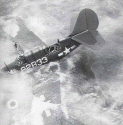 NS0303018 |
56k | SB2C Helldiver, 1944. |
Courtesy of Scott Koen & ussnewyork.com | |
 NS0303005 |
125k | USS Charger anchored in Hampton Roads, 1944. The island was built out over the side of the ship, to entirely clear the flight deck, and was not supported by the hull or the hangar side, thus requiring dedicated supports (one of them clearly visible under the island structure). Charger was armed with a single 5"/51 gun, aft, and two single 3"/50s forward (visible here); a light battery of .50-cal machine guns was initially planned, but, as shown, 20-mm machine cannon were mounted instead. The "X" superimposed on the ship's hull number, aft, indicated that the flight deck was not usable for landings. Photo by Edward L. Walger PH2 USN, 1942-1945. |
Barbara Walger | |
 NS0303012 |
78k | USS Charger (CVE-30) underway in January 1944, showing a very basic radar fit: SC-2 air search and the smaller SG surface search antenna below it; at the masthead is the YE aircraft homing beacon. |
Robert Hurst | |
NS0303020 |
52k | USS Charger (CVE-30) underway January 1944. She carries one 5"/51 aft and two 3"/50s forward. A light battery of six 0.50-cal mgs was originaly planned, but 20-mm guns were mounted instead. By the time this photograph was taken Charger had been fitted with more modern electronics, including an SC-2 air search radar and a YE aircraft beacon. Photo and text from U.S. Aircraft Carriers: An Illustrated Design History, by Norman Friedman. |
Robert Hurst | |
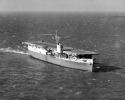 NS0303042 |
477k | USS Charger (CVE-30), 3 pts off starboard bow, 6 January 1944. Official U.S. Navy Photograph, now in the collections of the National Archives and Records Administration (NARA), # 80-G-208394. |
NARA, via Michael Mohl |
|
 NS0303027 |
32.7M | "Planes landing, launching, crash, aboard USS Charger" (CVE-30), 21 March 1944. National Archives at College Park, Motion Pictures, Local Identifier: 428-NPC-1501. Format: WMV (silent) Duration: 4' 1" Size: 640 x 480. |
National Archives | |
 NS0303017 |
217k | An ASW paint scheme-clad TBF-1 Avenger "in the groove" for landing aboard USS Charger (CVE-30), Chesapeake Bay area, on 22 April 1944. USN, courtesy Russ Egnor. Photo and text from Carrier Air War In Original WWII Color, by Robert Lawson and Barrett Tillman. |
Robert Hurst | |
 NS0303015 |
83k | An FM-2 Wildcat fighter prepares to take off from USS Charger (CVE-30) during training operations in the Chesapeake Bay area, 8 May 1944. Another FM-2 is passing overhead with its tail hook down, apparently having received a "wave-off" due to the carrier's fouled flight deck. Note the light Atlantic area paint schemes worn by these planes. Official U.S. Navy Photograph, now in the collections of the National Archives (# 80-G-K-1601). |
Robert Hurst | |
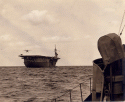 NS0303006 |
93k | A Grumman F4F Wildcat landing aboard Charger. Taken from a Coast Guard cutter in October 1944.
Photo by Edward L. Walger PH2 USN, 1942-1945. |
Barbara Walger | |
 NS0303024 |
107k | A Ryan FR-1 Fireball on the catapult of the escort carrier USS Charger (CVE-30) in 1944–46. Note lengthy holdback cable which leads to holdback unit located under cockpit.
Naval Aviation News magazine, August 1946 issue. (See also photo NS-cve30-w20.) |
Bill Stevens, USN (Ret). A-4/A-6 pilot. Naval history (aviation) buff. | |
 NS0303033 |
163k | SB2C Helldivers in flight over USS Charger (CVE-30), circa 1945. Photo from the collection of Roy (Swede) Moore, who was commissioned in April 1945 as a pilot and flew TBF Avengers and Helldivers, as well as Corsairs postwar. |
HS1 Steve Martin, USCG (Ret.), nephew of Roy Moore | |
 NS0303041 |
77k | No. 2 F8F-1 Bearcat (BuNo 90438) conducting trials aboard USS Charger (CVE-30), 17 February 1945. |
Tommy Trampp | |
 NS0303047 |
325k | Unusual to be seen up the Hudson River. This is ex-USS Charger (CVE-30), left, and ex-USS Wake Island (CVE-65), right, in the Hudson River, MARAD berthing anchorage, around April 1946. They were slated for disposal at decommissioning. From a MARAD photo set of Dave Schroeder. |
Dave Schroeder and John Chiquoine |
|
 NS0303008 |
114k | Performances by the ship's band, "The Superchargers." |
Steven C. Irwin | |
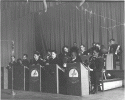 NS0303009 |
94k | |||
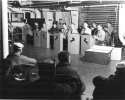 NS0303009a |
524k | |||
| Commercial Service |
||||
 NS0303050 |
37k | A fine undated view of MS Fairsea at anchor in Freemantle (Perth), Australia. |
Courtesy of Reuben Gossens of ssMaritime.com, via Robert Hurst | |
 NS0303034 |
21k | The motor ship MS Fairsea (ex-USS Charger) underway on her official maiden voyage as an immigrant ship, 31 December 1949, en route from Genoa, Italy, to Melbourne, Australia. |
Courtesy of Reuben Gossens of ssMaritime.com, via Robert Hurst | |
 NS0303028 |
46k | MV Fairsea, ex-USS Charger (CVE-30), ex-HMS Charger (D27), ex-US BAVG-4. |
Courtesy of Alfons Verheijden | |
 NS0303044 |
29k | A postcard of the motor ship MS Fairsea underway, released in January 1954. |
Courtesy of Reuben Gossens of ssMaritime.com, via Robert Hurst |
|
 NS0303044a |
19k | Motor ship MS Fairsea underway in 1954, after she received a shapely new funnel and a tripod mast on her bridge. Note the derricks aft; these would be removed at the next refit. |
||
 NS0303049 |
18k | MS Fairsea underway at Wellington, New Zealand, circa 1957. |
Courtesy of Reuben Gossens of ssMaritime.com, via Robert Hurst |
|
 NS0303046 |
19k | MS Fairsea underway after her 1958 refit. Although still very much a C3 class ship, her lines were more pleasing. |
Courtesy of Reuben Gossens of ssMaritime.com, via Robert Hurst |
|
 NS0303046a |
25k | |||
 NS0303016 |
192k | According to my information, the Fairsea was the former escort carrier Charger (BAVG-4), later re-numbered the AVG-30, finally the CVE-30. She was sold to Italian interests in 1949, received the name Fairsea and was converted to a passenger liner. She was then engaged for many years in carrying emigrants from the U.K. to Australia. In January 1969 she suffered a major engine breakdown and fire off Balboa, Panama and was towed to Balboa. Sold to Italian breakers, she was towed to La Spezia (Italy) where she was broken up in 1969. Photo from an out-of-print book on passenger ships published in 1965. |
Photo and text courtesy of Gerhard Mueller-Debus | |
 NS0303021 |
87k | "LINER ADRIFT—The 13,432-ton passenger vessel, Fairsea was reported adrift about 990 miles west of the Panama Canal today with 986 persons aboard after a fire disabled her engine. According to U.S. Coast Guard reports, the ship was en route for Balboa when the accident happened. Sea conditions were reported calm in the area and the ship was reported riding easily. (AP wirephoto) [24 January] 1969. 1955 photo." |
Tommy Trampp | |
|
||||
| Crew Contact and Reunion Information Web Sites |
| U.S.Navy Memorial Foundation Fleet Reserve Association |
| Related Links |
|
Hazegray & Underway World Aircraft Carrier Pages By Andrew Toppan. Escort Carrier Sailors & Airmen Association The Doxford: Opposed Piston Oil Engine, by Alfons Verheijden |
| Main Photo Index |
Escort Carrier Photo Index Page |
Comments, Suggestions or Image submissions, E-mail Carrier Information
Problems and site related matters, E-mail Webmaster
This page was created by Paul Yarnall and is maintained by Fabio Peña
![]()
Last update: 24 March 2025